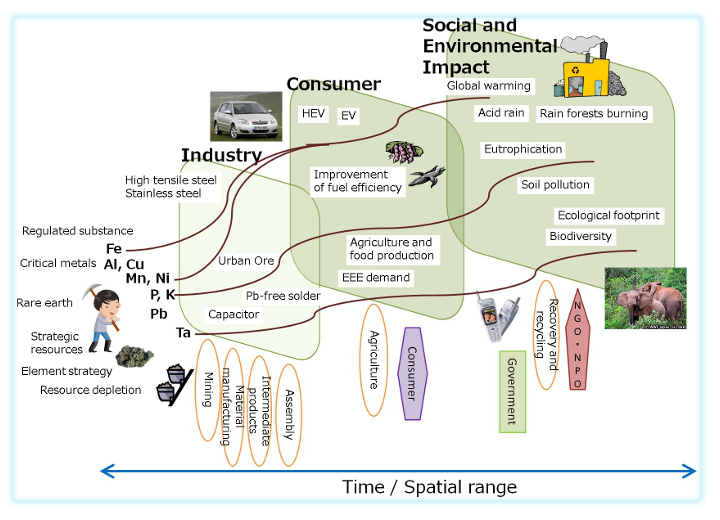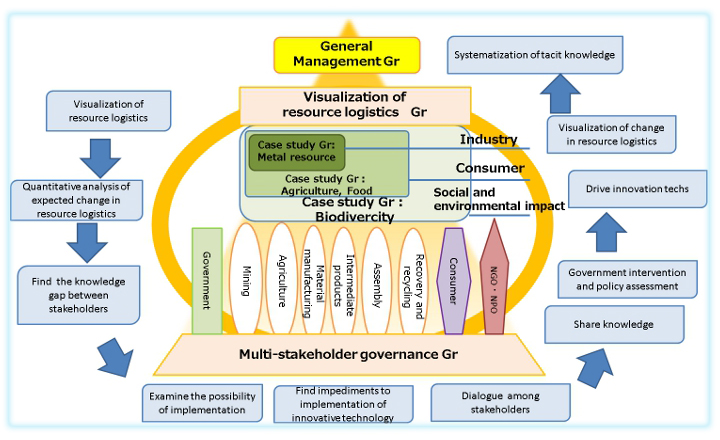R&D Projects
Resource Logistics as a Support Tool of Science,Technology and Innovation Policy Decision
Project Director

MATSUBAE Kazuyo
Associate Professor, Department of Metallurgy, Graduate School of Engineering, Tohoku University
Objective
This project aims to achieve the following three outcomes and proposes a methodology for extracting stakeholders and managing risk when implementing innovative technology, based on the visualization of resource logistics related to science and technology policies that Japan should pursue.
- Proposal of a methodology for the visualization of resource logistics
Visualization of the flow of subject elements through the supply chain in society (at the element level, material level, and product level)
Suggestion of a methodology for extracting stakeholders
Analysis of the changes in resource logistics caused by the implementation of innovative technology and its ripple effects on the society and economy
Classification of risks associated with the implementation of innovative technology - Proposal of methodology to extract stakeholders to be involved in the creation and implementation of innovation and risk management based on case studies
- The systematization of implicit knowledge based on successful cases of risk management in implementing innovative technology. As far as the ongoing cases are concerned, while committed to the evolving discussions, we will produce a support manual by examining the proposal system and methodology. This manual will assist in avoiding the various risks expected to accompany the creation and implementation of innovation in collaborations involving multiple stakeholders.
This project ultimately aims to propose a methodology for visualization that is effective in avoiding risks, can be used in areas other than resource strategy, and can provide support for policy making as a means of risk avoidance.
Outline
Scientific technologies are researched, developed, and then disseminated to the wider society under resource and environmental constraints. Resource limitations lead to the creation of new green innovative technologies, which in turn generate additional resource demands. In fact, innovations in science and technology (S&T) are important drivers of economic performance. However, we have inadequate knowledge to develop scientific and technological innovations to solve problems and to implement new social value in society. In order to facilitate innovation, it is necessary to understand the flow of resources in the supply chain. However, the bottom-up approach does not provide a comprehensive understanding of the changes in the resource demand structure of supply chains caused by the application of innovation and the diffusion of resources through exhaust emissions. Further, the current scenario of resource utilization creates a complicated network among stakeholders and is not conducive to the development of innovative technologies.
Considering the above points, we propose a method for visualizing resource logistics such as where, how, and how much resources are utilized in each field; what kind of changes are expected in the utilization of resources with the introduction of new technology; and what are the ripple effects of technological innovation in the supply of resources, which could face physical and economic barriers when used. The project also aims to extract the number of stakeholders involved in logistics and demonstrate the extent of their involvement.
Stakeholder dialogue is important for the introduction and implementation of new technology and insufficient knowledge sharing among them can lead to miscommunication. The visualization of resource logistics enables stakeholders to share information and be aware of the knowledge gaps among themselves. By clarifying resource logistics, it becomes possible to understand the flow of resources such as metal and materials and the products processed within the supply chain. This also makes it possible to understand the efficiency of the system and to identify ways of avoiding resource risk. This project attempts to identify the critical nodes in the supply chain network, which will help in determining the areas that need further research and the focus of development in relation to new innovative technology, from the viewpoint of avoiding resource risk in the supply chain.






